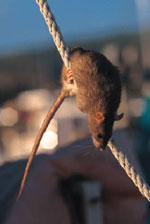Mortality threats
to Birds - Black Rat (Rattus rattus)
Overview
The black rat, also known as roof rat and ship rat, was originally a native of tropical Asia and spread through the Near East in Roman times before reaching Europe in the 8th century. The black rat then spread with Europeans throughout the world. It was introduced into North America in the 16th century, and is now prevalent in subtropical and tropical parts of the U.S. It is established on at least 28 groups of Pacific islands. Black rats will feed on and damage almost any edible thing. Black rats can live in a wide variety of habitats including woodlands, agricultural areas, coastal areas, grasslands, and urban areas. This rat is capable of spreading diseases such as bubonic plague, typhus, and trichinosis, and destroys property.
Description
Usually brown with black intermixed in color; can be gray to black above with underside white, gray, or black; a good climber; 16-20 cm long with a 19-25 cm scaly uniformly dark tail; pointed muzzle. Nocturnal and omnivorous, prefers grains. Can breed throughout the year; with 3 - 6 litters/year with up to 20 young. Can form social groups of up to 60. Nests in or under vegetation and in trees.
Birds Affected
The black rat has directly caused or contributed to the extinction of many wildlife species, including birds, small mammals, reptiles, and invertebrates, especially on islands. They prey on the eggs and young of forest birds and ground-nesting birds such as shearwaters, petrels, albatrosses, and endemic Hawaiian birds. The black rat is the rat most frequently identified with catastrophic declines of birds on islands.
Control
Black rats can be eradicated from small areas or seasonally controlled using rat poison products. Second-generation anticoagulant poisons such as brodifacoum have been successfully used for rat control, but potential for poisoning of birds and other wildlife that need to be protected (either directly or by predators/scavengers eating dead or dying rats) means only experienced applicators with wildlife training should apply the poison. |
